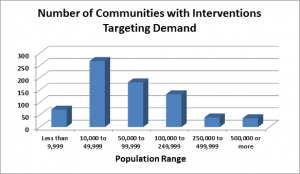Smaller Communities Adopting Big City Tactics on Prostitution
Categories: blogposts
![]()
Prostitution and sex trafficking are not strictly urban problems, and with the advent of web-based solicitation and wireless technology, are becoming even more decentralized. Police “reverse sting” operations using women officers as decoys to arrest sex buyers have occurred in towns with as few as 100 residents, and in at least 55 communities with populations of less than 5,000. The average size of cities that have conducted reverse stings is about 46,000. Community complaints were found to drive most police activity in response to prostitution.
Communities using anti-demand tactics: A 2011 study by Abt Associates, conducted for the National Institute of Justice, examined police operations and other initiatives that target men who buy sex from women and girls engaged in prostitution. The study has identified over 1,050 cities and counties in the U.S. that have conducted reverse stings and, in many cases, additional interventions targeting male buyers. Reverse stings and other tactics were found to have been used in all 50 states and in communities of all sizes. Over 110 towns with populations under 10,000 have conducted reverse sting operations and over 620 communities with populations under 75,000 have targeted sex buyers in that manner. Eight towns with population of less than 1,000 have conducted reverse stings, including Medora, ND (pop. 111) and Pollocksville, NC (pop. 315). Clearly, very small communities can have commercial sex problems significant enough to drive police to attempt to attack its source – consumer-level demand – and can muster the resources necessary to do so. In very small towns, reverse stings are usually accomplished through partnerships with other municipal or county law enforcement agencies.




Comments are closed.